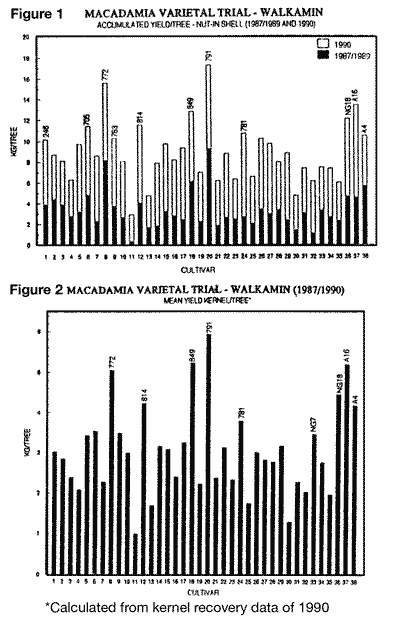
MACADAMIA CULTIVARS FOR NORTH QUEENSLAND
SCIENTIFIC NAME: Macadamia integrifolia
FAMILY: Proteaceae
THE EXISTING INDUSTRY
The most widely planted macadamia cultivars in north Queensland currently are Keaau (660), Kau (344) and Keauhou (246). However, recommendations accepted by the northern industry are based on southern Queensland/New South Wales experience. There are now some 1,000 hectares of macadamia on the Atherton Tableland, ranging from Emerald Creek in the north to the area encompassing Walkamin, Malanda and Ravenshoe. The altitude range is from 300 to 900 metres. There is also a small planting at Woodstock, south of Townsville. Plantings in the region have only been made since 1978.
CULTIVAR DEVELOPMENT
The need for a comprehensive evaluation of macadamia cultivars for north Queensland conditions was seen as early as the late 1970s, but a comprehensive trial was not run until 1984, when 38 cultivars were planted on a property at Walkamin. The cultivars were chosen from a range of new and older introductions from Hawaii and a selection of those developed in Queensland (Treatment numbers 28 to 38). Henry Bell's selections A4 and A16, (which now have patent rights) were also included.

DESIRABLE CHARACTERISTICS
Desirable features for macadamias are:
• early bearing;
• high yields;
• complete drop over a short period (no stick-tight);
• large nut and kernel size;
• high kernel recovery (preferably over 30%);
• high % first grade kernels after cracking;
• good processed quality;
• easily managed tree (minimum of pruning for
tree formation);
• long production life;
• resistance to breakage in strong winds; and
• pest-resistance.
In a cyclone-prone environment such as north Queensland, we need open-structured trees (e. g. 791). They let the strong winds through the canopy. Kan (344) suffered badly in some areas in cyclone Joy - probably because of the dense branch and leaf structure. Tree formation data is not presented in this article but should be examined by growers contemplating new plantings. The other variable which needs to be examined is tree yield/growth ratio.
Generally speaking, the early bearing cultivars (A4, A16, 791, 772, 849, 705 etc.) are slower-growing (because they are expressing more energy in nut production than growth). Twenty years after planting, the yield trends may be very different from what they are now at 7 years of age.
YIELD COMPARISONS
Graph 1 details NIS (nut in shell) tree production based on 10% moisture for 1987-1989 and 1990. The graph shows early bearing of 791, 772, 849, A16, 814, 705, NG18 and A4 in particular, - well above standard cultivars 660 8nd 344.
KERNEL RECOVERY
Graph 2 shows total kernel recovery per tree for the same period adjusted to 10% moisture. The pattern of yield is similar to NIS but the gap between cultivars is narrowed because of higher kernel recovery of some of the lower-producing cultivars. Growers are paid on the basis of kernel recovery; hence the important combination of high yield and good recovery.
QUALITY
Processors of macadamia nuts prefer large whole kernels (preferably over 2.5 g). Cultivars which crack well and give a large percentage of whole kernels are paid a premium. In times of lower prices, quality becomes more important.
THE FUTURE
When the Walkamin and a number of duplicate trials in Rockharnpton, Gunalda, Mt. Bauple, Gympie, Glasshouse Mountains and Lismore have run another four to five years, then we should be in a much better position to recommend those cultivars most suitable for north Queensland conditions.
It is interesting to note that yields from the Walkamin trial are as high as those in the other centres.
DATE: May 1992
* * * * * * * * * * * * *
